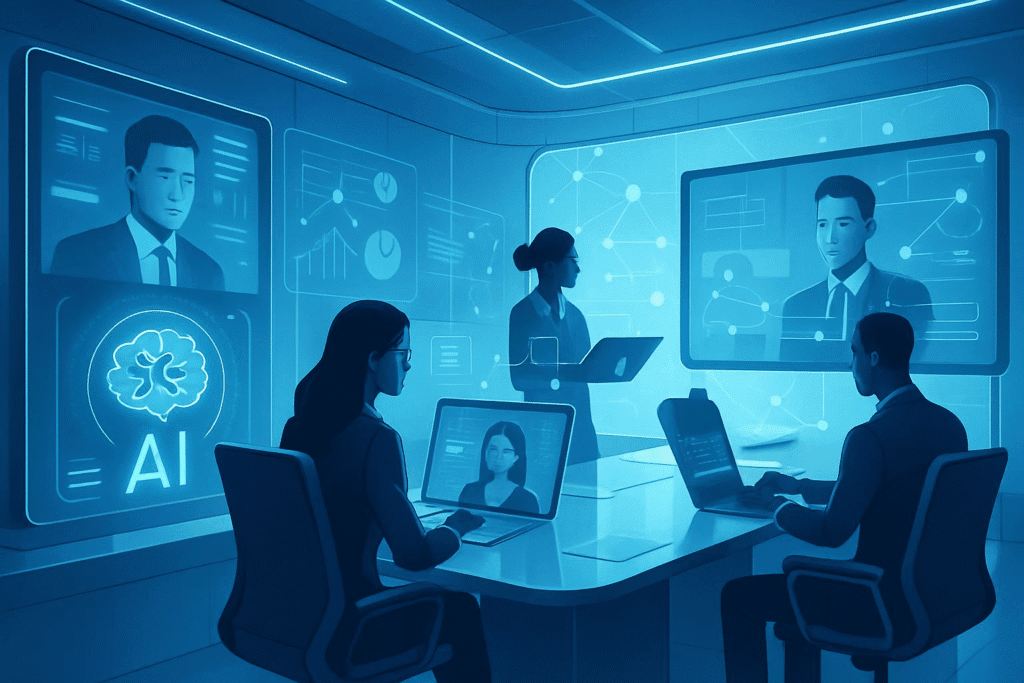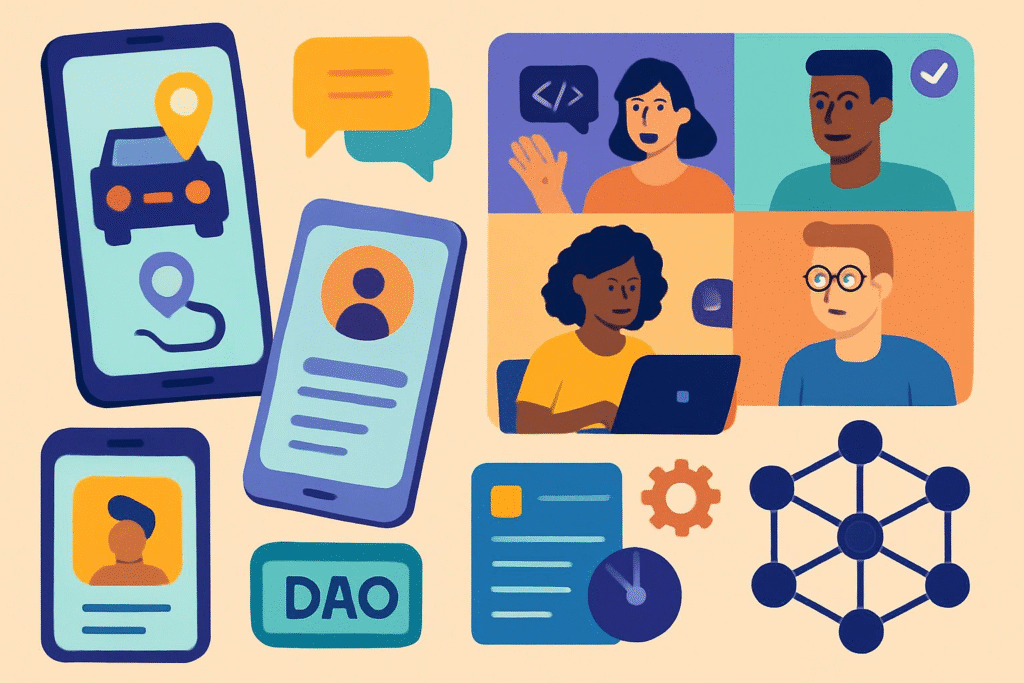Introduction

For much of the 20th century, the 9-to-5 job was more than just a schedule — it was a cultural norm, a symbol of economic progress, and a reliable path to stability. It made sense in an era shaped by factories, corporate hierarchies, and physical office spaces. But in 2025 and beyond, this once-standard work model is showing serious cracks — and fast.
We’re living through a profound transformation in how, when, and why we work. The digital revolution, combined with the explosive rise of remote work, freelancing platforms, AI automation, and shifting human priorities, is rewriting the rules of employment. Clocking in and out at fixed hours feels increasingly outdated in a world that rewards creativity, adaptability, and measurable impact — not just time spent at a desk.
Today’s workforce wants more than a paycheck. People are craving autonomy over their time, the freedom to choose where they work, and a deeper connection to what they do. The emphasis is shifting from “hours worked” to “results delivered” — and the companies that understand this shift aren’t just surviving; they’re leading.
In this blog, we’ll unpack the major forces dismantling the traditional workday, spotlight the new models replacing it, and show you why adapting to this change isn’t optional — it’s essential. Whether you’re an ambitious professional, a business owner, or someone just trying to make sense of the chaos, what’s coming next in the world of work will affect you more than you think.
The Slow Death of the 9-to-5: What’s Really Replacing It?

While the 9-to-5 grind once symbolized security and structure, it’s no longer the blueprint for success. We’re not witnessing a simple change in scheduling — we’re living through a complete workforce revolution. This shift is being fueled by four major forces that are reshaping how we think about jobs, time, and productivity.
1. Remote Work and Freelancing Are Reshaping Expectations
The pandemic didn’t invent remote work — it merely ripped off the training wheels. What started as a temporary necessity has evolved into a global demand. Employees are now building careers without ever setting foot in an office, and they’re not looking back.
📊 According to recent surveys, over one-third of workers now operate entirely remotely, and 4 in 10 do so at least part of the time. What’s more telling? A significant number would accept lower pay in exchange for more control over where and how they work.
This isn’t just a shift in preference — it’s a declaration of independence from outdated systems.
2. AI and Automation Are Rewriting Job Descriptions
With the rise of artificial intelligence and automation, tasks once done manually are now handled with minimal human input. This doesn’t just reduce workloads — it redefines them.
Instead of measuring productivity by hours logged, companies are moving toward outcome-based performance. Why tie people to desks when machines can handle the mundane, and humans can focus on innovation?
Experts are already forecasting a not-so-distant future — perhaps as soon as 2034 — where the traditional full-time job is the exception, not the rule.
3. A New Generation, A New Set of Priorities
Today’s workforce, especially Millennials and Gen Z, isn’t just chasing paychecks — they’re pursuing meaningful work that aligns with their values.
The new ideal? Freedom, flexibility, and fulfillment. Younger professionals aren’t afraid to walk away from structured office jobs if it means gaining better mental health, work-life harmony, or a purpose-aligned mission.
Meanwhile, the gig economy continues to explode, offering more individuals a chance to work on their terms — as consultants, creatives, coders, or creators. The rigid employment model? It simply can’t compete.
4. Office Walls Are Crumbling — Literally and Culturally
COVID-19 may have forced the first wave of remote adoption, but it also exposed a truth long known to many: the traditional office setup isn’t always the most productive or humane.
Burnout, long commutes, and lack of flexibility have made office life unsustainable for many. And the data backs this up — remote workers are not only happier but 13% more productive on average than their in-office counterparts.
The physical office isn’t just shrinking — it’s becoming irrelevant for roles that thrive on focus, independence, and asynchronous collaboration.
The New Normal: Flexible, Focused, and Human-Centric
The era of clocking in and out for the sake of appearances is ending. What’s emerging is a more agile, decentralized work culture — one that values autonomy over attendance, results over routines, and innovation over inertia.
The question now isn’t “Is the 9-to-5 model dying?” It’s “What’s taking its place — and how can we adapt before we’re left behind?”
The Rise of Flexible Work: Reimagining How (and Where) We Work

The collapse of the rigid 9-to-5 schedule hasn’t left a vacuum — it’s made space for something more adaptable, human-centered, and innovative. Flexible work isn’t a fringe benefit anymore — it’s becoming the default expectation for professionals across industries.
Let’s break down the pillars of this new work era and why they’re fundamentally changing the game.
1. The Gig Economy: Freelancers Are the New Workforce Majority
Once considered a side hustle playground, the gig economy is now a major force in global employment. More professionals are walking away from traditional jobs to become self-managed freelancers, drawn by the appeal of freedom, variety, and control.
Platforms like Upwork, Fiverr, and Toptal have democratized access to income — allowing people to earn from anywhere, on their own schedule, without the restrictions of an employer.
📈 And this isn’t a small shift: projections show that more than half of the global workforce will be freelancing by 2030. That means the majority of skilled labor could soon be operating independently, not under any one employer.
This isn’t just economic evolution — it’s a cultural shift. People are no longer just asking, “Where can I get a job?” but, “How can I design a life that gives me both income and freedom?”
2. Hybrid Work Is the New Corporate Standard
The hybrid work revolution is redefining office culture from the inside out. Instead of forcing employees into full-time remote or in-office roles, companies are embracing fluid schedules that balance collaboration with personal flexibility.
What we’re seeing is more than a compromise — it’s a complete rethinking of workspaces. Offices are being redesigned as hubs for brainstorming, mentorship, and human connection — not just rows of desks for grinding.
📊 A recent survey found that 60% of business leaders now view hybrid models as the most sustainable path forward. Why? Because they’ve seen firsthand that productivity doesn’t come from presence — it comes from trust and flexibility.
3. Decentralized Work: Blockchain Is Rewriting Job Contracts
Welcome to the age of work without borders or bosses. Emerging decentralized models — powered by blockchain and DAOs (Decentralized Autonomous Organizations) — are transforming how teams collaborate and how compensation flows.
In these models, workers don’t take on job titles — they take on projects. They’re paid based on outcomes, not hours. There’s no hierarchy — just contribution and consensus.
While this may sound futuristic, it’s already happening. Thousands of professionals are earning crypto, contributing to decentralized startups, and participating in fully remote organizations that don’t even have a central office or CEO.
The appeal? Total autonomy. Transparent payment systems. And work that scales globally — without bureaucracy.
4. AI and Automation: The Invisible Workforce Behind the Scenes
Flexible work isn’t just enabled by culture — it’s powered by technology. Artificial intelligence is stepping in to handle repetitive, rule-based tasks, freeing up human talent for creative, strategic, and high-impact work.
AI tools now schedule meetings, write reports, organize data, and even handle first-level customer support — tasks that used to demand hours of manual effort. This efficiency lets employees focus on what truly matters: problem-solving, storytelling, innovation, and leadership.
Automation also makes it easier to build global teams, since workflows can now be managed asynchronously and across time zones — no central office required.
The result? Teams that move faster, think smarter, and operate leaner — all while employees gain back time and sanity.
Welcome to the Future of Work — It’s Flexible by Design
The new world of work isn’t one-size-fits-all — and that’s exactly the point. Whether it’s the rise of freelancing, hybrid schedules, or decentralized startups, what’s clear is this:
Control is shifting away from corporations and into the hands of individuals.
Employees today want more than a paycheck — they want freedom, purpose, and the power to choose how they work. And flexible work models are delivering just that.
The companies that resist this shift will struggle to attract top talent. The ones that embrace it? They’ll become magnets for innovation.
How Technology Is Rewiring the Way We Work — Forever

Behind the fall of the traditional 9-to-5 lies a more powerful and unstoppable force: technology. What used to require office buildings, clock-in systems, and layers of middle management can now be done faster, smarter, and from anywhere in the world — thanks to digital transformation.
Let’s unpack how advanced tech tools are not just supporting flexible work, but actively reshaping the DNA of modern employment.
1. AI and Automation: From Clock Hours to Creative Hours
Artificial intelligence isn’t just making businesses faster — it’s fundamentally altering how we measure productivity.
Repetitive tasks like data entry, scheduling, customer service, and inventory management are increasingly handled by smart systems. This shift doesn’t just save time — it breaks the old logic of “productivity equals hours spent.”
Now, companies are focusing on results, not routines. Employees are free to invest their energy into more strategic, creative, and emotionally intelligent work — the kind of tasks that machines can’t replicate (yet).
And with AI tools embedded into daily workflows, employees can get more done in less time, with fewer mental drains. The result? Higher efficiency, less burnout, and a seismic change in how we define a “workday.”
2. Blockchain and DAOs: The Birth of a Borderless Work Economy
Blockchain isn’t just for crypto — it’s laying the foundation for a new kind of workforce infrastructure.
With blockchain, trust is embedded in code. Transactions, contracts, and work agreements are transparent, secure, and decentralized. This enables organizations to form without traditional leadership structures — known as Decentralized Autonomous Organizations (DAOs).
Inside a DAO, there’s no CEO assigning tasks. Contributors from across the globe take on project-based roles, get paid in crypto, and vote on organizational decisions. It’s flat, fair, and flexible — and it’s growing fast among tech-forward communities.
This isn’t a fringe experiment anymore — it’s a glimpse of what decentralized work could look like at scale.
3. Virtual Workspaces & the Metaverse: The Office Goes Digital
Imagine attending a meeting in a virtual boardroom where your team’s avatars are seated across from you — even though everyone is in a different country. Welcome to the metaverse at work.
With advancements in VR (Virtual Reality) and AR (Augmented Reality), companies are investing in digital office environments that offer immersive, real-time collaboration without the constraints of geography.
These aren’t just cool gadgets — they’re strategic tools. Virtual workspaces allow teams to maintain presence, culture, and creativity without requiring physical offices. From training simulations to interactive brainstorming sessions, the metaverse is opening a new frontier for remote collaboration.
It’s no longer about where we work — it’s about how deeply we can connect, no matter the distance.
4. Tech-Enhanced Productivity & the New Work-Life Balance
It’s not just about doing more — it’s about doing better. Technology is enabling workers to craft sustainable, balanced careers by optimizing both workflow and wellness.
- AI-powered scheduling tools minimize time waste.
- Automation reduces menial work, leaving space for real thinking.
- Remote collaboration platforms (like Slack, Zoom, Notion, and Miro) enable teams to work asynchronously — meaning less stress and more autonomy.
📈 And the numbers don’t lie: multiple studies show that remote employees using these digital tools report higher productivity and job satisfaction than their in-office peers.
In short, we’re not just working differently — we’re working smarter, and living better as a result.
What We Gain When the 9-to-5 Dies: Real Benefits of the Flexible Work Revolution

As we step away from the outdated 9-to-5 grind, we’re not just ditching cubicles and commutes — we’re gaining a new way of living and working that puts people first. The shift to flexible, decentralized work isn’t just a trend — it’s a total upgrade for both employees and employers.
Here’s how this new world of work is unlocking real-life advantages that were once considered impossible under traditional employment models.
1. A Healthier Balance Between Life and Work
The rigid 8-hour office day rarely left room for life’s other priorities. Now, flexible work puts control back in workers’ hands.
- Parents can schedule work around family time.
- Creatives can follow their energy peaks — not just the clock.
- Mental health gets prioritized, not pushed aside.
📊 Research consistently shows that people with flexible work arrangements report lower stress levels, better sleep, and greater overall well-being.
This isn’t just about working differently — it’s about living better.
2. Productivity That Actually Makes Sense
When people are allowed to work when and how they work best, performance skyrockets.
- Remote-first companies are growing revenue up to 4x faster than traditional ones.
- Productivity metrics are shifting from hours logged to results delivered.
- People no longer need to “look busy” — they can actually get things done.
The future belongs to businesses that value impact over attendance — and workers who thrive on autonomy.
3. No More Commute, No More Chaos
One of the most immediate wins of remote and hybrid work? Saying goodbye to the daily grind — literally.
- The average commuter reclaims 5–10 hours per week.
- Annual savings on fuel, transit, and meals easily exceed $2,000.
- And let’s not forget: less traffic means fewer emissions, making this shift good for the planet, too.
Remote work doesn’t just save time — it gives it back to the things that matter.
4. Career Freedom Without Borders
In the post-9-to-5 era, talent is no longer limited by location.
- A developer in Nairobi can collaborate with a team in Berlin.
- A writer in Mumbai can freelance for startups in New York.
- A designer in Lisbon can land gigs from Tokyo to Toronto.
This global talent pool fuels more innovation, more diversity, and more opportunity — especially for workers in emerging economies.
Meanwhile, companies benefit by hiring the best people for the job, not just the ones within driving distance.
5. Space for Passion, Creativity, and Entrepreneurship
Perhaps the most exciting shift? People now have the freedom to build lives that reflect who they are — not just what their job demands.
- Side hustles become full-time businesses.
- Passion projects evolve into profitable ventures.
- Creators, makers, and dreamers have the time to actually create, make, and dream.
We’re entering an era where your job doesn’t define you — your choices do.
What’s Replacing the 9-to-5?

Spoiler alert: It’s not just working from home in pajamas.
The traditional 9-to-5 job isn’t just being questioned — it’s being systematically replaced by work models that prioritize freedom, fulfillment, and future-readiness. Driven by tech innovation, global connectivity, and changing values, today’s workforce is crafting a landscape where results matter more than routines.
Let’s explore the powerful alternatives that are rising in its place.
1. The Rise of the Gig Economy & Freelance Nation
The gig economy has gone from a side hustle trend to a global employment force. Millions are choosing freelance work because it offers something the 9-to-5 never could: control.
- Platforms like Upwork, Fiverr, and Toptal make it possible to monetize your skills without answering to a boss or a punch clock.
- Whether you’re a designer, developer, marketer, or writer — there’s a market for you.
- 🔮 Forecasts suggest that freelancers will make up over half the workforce by 2030, reshaping what it even means to have a “job.”
This isn’t just freedom — it’s financial and lifestyle sovereignty.
2. The Four-Day Workweek: More Done in Less Time
Once considered a radical idea, the four-day workweek is now a serious contender in the race for a healthier, smarter work model.
- Companies in Iceland, Japan, and New Zealand have tested it — and the results are in: higher productivity, better morale, and fewer sick days.
- By condensing the same workload into fewer days, employees work with focus instead of fatigue.
- 📉 Burnout rates drop. 📈 Output rises. It’s a win for both sides.
More and more companies are realizing: when people have time to rest and live, they come back to work fired up to deliver.
3. Remote & Hybrid Work: Flexibility Becomes the Default
Remote work isn’t just a pandemic phase — it’s now the expectation.
- Hybrid models allow employees to customize how they work, balancing in-person collaboration with solo productivity.
- Offices are evolving into collaboration hubs, not daily destinations.
- According to recent surveys, over 60% of business leaders now support hybrid work as a long-term strategy.
This shift is about more than convenience — it’s about trusting workers to manage themselves, and rewarding them for output, not attendance.
4. DAOs & Blockchain: Redefining the Workplace from the Code Up
Decentralized Autonomous Organizations (DAOs) are quietly building the infrastructure of the future workforce.
- Powered by blockchain, DAOs enable people from across the world to collaborate on shared goals without a traditional hierarchy.
- Instead of full-time roles, contributors work on flexible, project-based gigs with transparent pay and governance.
- These structures reward contribution, not compliance — and many believe they’ll become the new normal for digital-native professionals.
This isn’t just a new work model — it’s a work revolution without borders, bosses, or bureaucracy.
5. Financial Independence & The End of Career Chains
The rise of the FIRE movement (Financial Independence, Retire Early) signals a deeper cultural shift: people are no longer working just to survive — they’re working to escape the cycle altogether.
- Individuals are investing smarter, saving aggressively, and building passive income streams that allow them to retire in their 30s or 40s.
- Digital entrepreneurship, content creation, affiliate marketing, and real estate are becoming paths to financial freedom, not just side hustles.
- The goal? Replace “grind now, rest later” with “design a life that doesn’t need escaping.”
This trend reflects a larger truth: People want purpose, not just paychecks.
Amazon Books Recommendation Section
Looking to dive deeper into the collapse of the 9-to-5 and the rise of flexible, purpose-driven careers? These handpicked books offer powerful insights into how work is evolving — and how you can stay ahead of the curve.
🔹 1. The End of Jobs: Money, Meaning and Freedom Without the 9-to-5
Author: Taylor Pearson
Perfect For: Entrepreneurs, freelancers, and anyone rethinking traditional employment.
Why You’ll Love It: Pearson breaks down why conventional jobs are vanishing and how you can build a career that prioritizes autonomy, income scalability, and freedom.
👉 Check it out on Amazon
🔹 2. Remote: Office Not Required
Authors: Jason Fried & David Heinemeier Hansson (Founders of Basecamp)
Perfect For: Teams, managers, and remote workers wanting practical strategies.
Why You’ll Love It: This book offers a blueprint for thriving without the office. It’s ideal if you’re building or working within a remote or hybrid team.
👉 Find it on Amazon
🔹 3. The Future of Work: Robots, AI, and Automation
Author: Darrell M. West
Perfect For: Tech enthusiasts, futurists, and policy thinkers.
Why You’ll Love It: A fascinating look at how artificial intelligence and automation are reshaping labor markets, job structures, and the global economy.
👉 Explore it on Amazon
🔹 4. Work Without Jobs: How to Reboot Your Organization’s Work Operating System
Authors: Ravin Jesuthasan & John W. Boudreau
Perfect For: Business leaders, HR professionals, and consultants.
Why You’ll Love It: It lays out how companies can thrive in a world without rigid roles, where project-based and skill-based models replace old job structures.
👉 Grab it on Amazon
Conclusion: The 9-to-5 Is Dead—Now What?
The 9-to-5 work model isn’t just fading—it’s being actively replaced. What once symbolized job security and structure now feels increasingly outdated in a world that thrives on speed, creativity, and flexibility.
Today’s workforce doesn’t want to be chained to a desk, watching the clock tick. People crave autonomy, meaningful work, and the freedom to shape their own schedules. Whether it’s the rise of remote collaboration tools, the explosion of the gig economy, or the power of AI-driven productivity, the shift is undeniable—and irreversible.
💡 Here’s the bottom line:
The future of work belongs to those who can adapt quickly, work smartly, and think beyond traditional roles. From freelancers building global careers from coffee shops, to DAOs coordinating decentralized teams, the new economy rewards results—not hours logged.
The real question isn’t “Will the 9-to-5 die?”
It’s “Are you ready to evolve with what’s coming next?”
Because the future of work isn’t on a clock—
⏱️ It’s on your terms.
FAQs
Why is the traditional 9-to-5 work model disappearing?
Because it no longer fits how we live or work.
The 9-to-5 was built for the industrial era, not the digital one. Today’s workers value freedom, flexibility, and meaningful output — not just showing up and logging hours. Add in remote tech, AI automation, and generational shifts in priorities, and it’s clear: the old model just can’t keep up.
What’s replacing the 9-to-5?
A mix of flexible, decentralized, and tech-driven models.
We’re seeing a rise in freelancing, remote work, gig platforms, hybrid roles, and even project-based employment through DAOs (Decentralized Autonomous Organizations). It’s less about being somewhere at a certain time — and more about delivering results from anywhere.
How is automation affecting traditional jobs?
It’s eliminating the boring stuff — and redefining what “work” means.
Repetitive tasks are being automated by AI and machine learning, freeing humans to focus on creative, strategic, and high-impact work. The shift means fewer jobs tied to hours and more jobs tied to expertise and value creation.
Will office jobs disappear completely?
Not entirely — but they’ll never look the same again.
Some roles will still need in-person collaboration, but most industries are moving toward remote-first or hybrid models. Companies that force a full return to the office risk losing talent to more forward-thinking competitors. The future is fluid, location-independent, and outcome-focused.
How can workers prepare for the post-9-to-5 world?
Start by thinking like a free agent.
Level up your digital skills, build a remote-friendly portfolio, and explore side hustles or freelancing platforms. Learn how to communicate asynchronously, manage your own schedule, and deliver measurable results. Those who adapt early won’t just survive — they’ll thrive.
